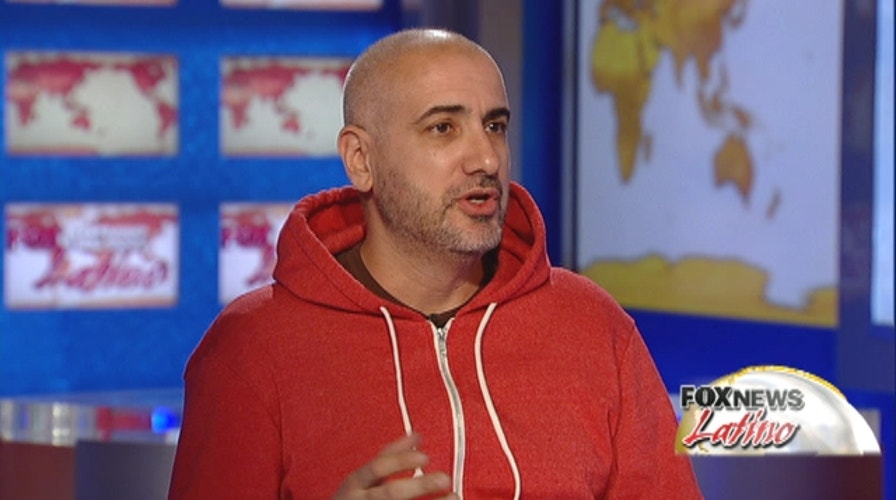Please click on the video above as Marvel Comics Editor In Chief Axel Alonso talks about Latino super heroes with Fox News Latino's Victor Garcia.
“Come here. You've got a head you don't need,” America Chavez, a.k.a. Miss America, tells established Marvel Comics character Loki, the god of mischief.
With her short shorts, boots and American flag-colored jacket, "tough girl" Chavez is yet another Latino moving to the forefront of a Marvel Comics franchise in Young Avengers Vol. 2 Issue number one.
“People out there reading our comic books are of all sizes, creeds and colors and it’s our responsibility to make them feel included,” Axel Alonso, editor in chief of Marvel Comics, told Fox News Latino. “This isn’t some PC initiative, this is capitalism. This is about supply and demand.”
But this is not the first time a Latino has been given top billing. Just last year, the media was in a frenzy over Marvel’s decision to kill off their “Ultimate” version of Spider-Man, Peter Parker, and replace the character with a half black, half Latino character named Miles Morales.
“For us, [the decision to change the character] was about many things,” said Alonso. “One of the things was the joy of knowing that there would be a child out there who would see Spider-Man peel back that mask to see a different face and a face that resembled their own.”
At the time, some speculated Morales was gay, though Alonso said that was actually a misunderstanding.
But diversity is making its way into the comic book world, and Marvel Comics has been at the forefront of this change by including scenarios and characters that reflect the changing face of America.
For example, openly gay superhero Northstar married his partner last year in the pages of Astonishing X-Men. And two teenage characters in the Young Avengers, Hulkling and Wiccan, are currently in a gay relationship.
The joy of knowing that there would be a child out there who would see Spider-man peel back that mask to see a different face and a face that resembled their own.
While black characters have evolved over time in comic books –including Luke Cage, from a blaxploitation background to what Alonso calls “hip-hop cool”– Latino characters have usually been relegated to smaller side characters.
But that trend has changed in recent years.
“If you took us back 10 years, you see that there has been a sea change,” said Frederick Aldama, an arts and humanities professor at Ohio State University who has written extensively on Latinos in comics. “These guys are smart. Yes, there are dollars involved but on the other hand they’re very attuned to the fact that the Latino demographic is larger.”
The other of the “big two” comic book publishers, DC Comics, has also added Latinos to their roster.
Their Blue Beetle is a Latino named Jamie Reyes, while the Question character is longtime established gay Latina Renee Montoya.
DC Comics declined to be interviewed for this story.
“We should be in all of the different kinds of formats,” said professor Aldama. “We’re appearing everywhere the superhero books as well as the independent and the biographic.”
Aldama credits a growing number of Latino writers and artists for the new Latino influence, as well as key players in editorial positions in these companies. That includes Alonso, whose father is Mexican.
“I think they’re very responsible in what they’re doing,” said Aldama.
Even with a growing number of Latino characters making their way in the comic "multiverses," Alonso and others stress that forcing or championing a Latino character on everyone isn’t the smartest approach.
“We ride the currents of time. We try to stay ahead of the curve as much as we can but we can't force an audience for anything,” said Alonso. “You can’t go in and say ‘let’s create a great Mexican superhero.’ What you do is let that evolve naturally and when the window of opportunity opens, you strike.”
Quality characters seem to be the way to encourage Latinos to follow Latino characters.
“We only will spend money on things that are decent,” said Aldama.
Todd Seavey, a writer who has written for DC comics and is currently the comics editor for LibertyIslandMag.com, says minority characters are best when they are not heavy-handed.
“If the character that is Latino seems like a random human being, that's probably better than if he's a living symbol of his race or nation,” said Seavey. “I think it's good and the best way to get the fans to accept it is to grow the characters of past stories.”
Seavey said some minority characters introduced in comic books seemed forced, and it turned out to be a disaster.
For example, DC comics once had a character named Estraño, a gay Latino magician who had HIV and referred to himself as “Auntie.”
One of Marvel’s more outdated characters is the Armadillo, a Mexican-American misunderstood villain who looks like a giant armadillo.
Alonso doesn’t believe stereotypes belong in comics but thinks the audience should have fun with cultures, like he did when he developed Mexican wrestler mercenaries the Zapata brothers.
“Is that a little stereotypical? Yeah but it’s also fun and a part of our culture,” said Alonso.
As for a change in the comic book landscape and whether or not Latinos will catch up, Alonso says the evolving audience is ultimately responsible.
“I think that Latinos have been underrepresented in comic books and I think that’s changing rapidly,” said Alonso. “You have to go back to the source material, the original comic books, who they’re created by, who they’re created for, what the audience was. And that audience has grown over time and evolved over time.”
Follow Victor Garcia on Twitter @MrVicGarcia.
Follow us on twitter.com/foxnewslatino

